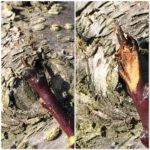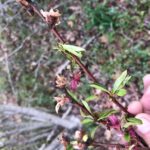Thierry E. Besançon, Rutgers University, and Lynn M. Sosnoskie, Cornell University
Many growers in the US have been focused on predicted herbicide shortages in the upcoming field season. While the primary concerns have surrounded glyphosate and glufosinate, there is increasing apprehension that active ingredients of importance to tree fruit and small fruit growers may also be affected. Although the supply change is dynamic, chemical stocks may become, and remain, tight at the local or regional level as growers try to fill gaps in their toolboxes. As spring residual herbicide are soon to be applied, please consider the following when planning for the 2022 season.
| Important note: Not all herbicides are available in all crops in both New Jersey and New York. Always review current labels before applying products |
Successful Weed Identification, Regular Scouting and Detailed Field Records are Crucial for Optimizing Weed Control Success
- The first step in developing a novel herbicide program is knowing what species are present and determining which combination of products will be the most effective (and affordable) at suppressing them. Not all active ingredients are equally useful against all species and careful consideration needs to be paid to each chemical’s spectrum of control. Please, carefully review herbicide effectiveness tables for various weed species that are available in the 2022 Commercial New Jersey Pest Control Recommendations for blueberry, tree fruits or grape (https://njaes.rutgers.edu/pubs/). Similar tables are available in Cornell’s weed control guides (PMEP Guidelines (cornell.edu))
Familiarize Yourself with Chemical Substitutes before Applying Them over Many Acres
- Some switches may be intuitive (e.g. using Poast (sethoxydim) or Fusilade (fluazifop) in place of clethodim where allowed) while others may be more complicated (e.g. using a tank-mixture in place of a single product). In addition to knowing a product’s target species, become acquainted with each herbicide’s labeled rate structure and spray volume, use patterns (e.g. application timing), environmental limitations (e.g. soil type or temperature restrictions), adjuvant requirements, and potential interactions with tank-mix partners. Not all chemicals are compatible with each other, and antagonism can reduce weed control efficacy while enhancing crop injury concerns. Contact your Extension Specialists if you have any doubt regarding physical compatibility and efficacy of herbicides mixtures.
Soil-Applied Preemergence Herbicides are Critical Tools
- Soil-applied preemergence herbicides are very useful tools for suppressing weeds that emerge with the crop; these plants are the most injurious as early season competitors are very likely to reduce yields. Like postemergence products, soil-applied herbicides must be carefully selected to balance crop safety with weed control needs. Pay attention to rate requirements according to soil type, as this can influence both efficacy and injury. Preemergence herbicides need to be moved (aka activation) into the soil solution (via either rainfall or irrigation) where they are taken-up by emerging weed seedlings; delays in activation can reduce overall performance if some weeds continue to germinate and emerge under low soil moisture conditions. Delays may also facilitate the degradation of some products susceptible to breakdown in sunlight (i.e. photolysis). Be aware that trickle irrigation may cause less effective and less consistent weed control by washing off residual herbicides from top soil where weeds germinate, thus increasing herbicide application costs. When possible, use overlapping residual products to suppress weed emergence throughout the season. Some active ingredients may have both preemergence and postemergence activity (e.g. flumioxazin (Chateau) or simazine (Princep)).
Timing Matters
- Postemergence (i.e. foliar) weed control should be undertaken when weeds are small and succulent. Herbicide labels will have specific recommendations regarding the optimal size for treatment. For instance, clethodim (Select Max) and sethoxydim (Poast) have a maximum height or lateral growth requirement of 6 inches for effective control of goosegrass or crabgrass. Weeds are more sensitive to control measures when they are small and succulent, so rapid identification and management will improve control success. Because many foliar-applied herbicides can also damage crops, as well, always follow label guidance to reduce risk of injury.
Optimize Herbicide Application Rate for Postemergence Applications
- Target using the lowest effective herbicide rate to stretch your herbicide supply. For example, instead of applying 32 or 44 oz/acre of a glyphosate brand product, consider using the standard rate on the label such as 22 oz/acre for Roundup PowerMax. Again, timing of application with regards to weed size will be critical to optimize your herbicide supply. The smaller the weeds, the less herbicide you will have to apply to control it! Therefore, frequent scouting as highlighted above will be very important to optimize your herbicide application and stretch your herbicide supply.
Don’t Skimp on Adjuvants
- If herbicides are going to be in short supply, then there may be fewer shots to control weeds. If there are fewer shots available, make every shot count as much as possible. Follow label recommendations regarding the inclusion of water conditioners, surfactants, etc…, to maximize product efficacy. Refer to point number two about potential compatibility concerns when tank-mix partners are involved.
Get Perennial Weeds under Control
- Perennial species such as Canada thistle, goldenrods, bindweed or quackgrass are frequent and troublesome weeds of tree fruit and small fruit crops. Because control of these weeds requires the use of systemic herbicides that may be in short supply (i.e. glyphosate), appropriate timing of application will be critical to maximize herbicide efficacy. For example, Canada thistle should be sprayed with a systemic herbicide in late spring after flower buds started to develop whereas Virginia creeper or poison ivy should be targeted in mid- to late summer after vines flowers but before fall color appears in the foliage. Use effective alternatives such as clopyralid (Stinger) for control of leguminous and composite (e.g. Canada thistle) weeds or soil-applied pronamide (Kerb) for control of perennial grasses where authorized. This may help you to reserve the use of glyphosate for perennial weeds that cannot be efficiently controlled by other products.
Consider Non-Chemical Weed Control Strategies When and Where Appropriate
- This includes hand weeding, cultivation, and mowing practices. Like herbicides, these practices are not effective against all species at all times. For example, while cultivation can control many weed seedlings, particularly at the white-thread stage, soil disturbance is less effective against well-developed plants. In the case of some perennials (for instance, field bindweed or Canada thistle), cultivation contributes to break up and disperse root fragments within and across fields, facilitating dispersal. Ultimately, plan for hand-weeding escapes prior to the weeds setting seeds as this will help reducing the weed seedbank for future growing seasons.
Plan Ahead Now!
- 2022 could be a difficult year if many crop production and protection chemicals are limited. Herbicide shortages could impact weed control success in the coming growing season…and beyond. Weeds that are not controlled in 2022 will set seed that will cause problems in the future. Planning now can help with weed management in both the short and long term.


